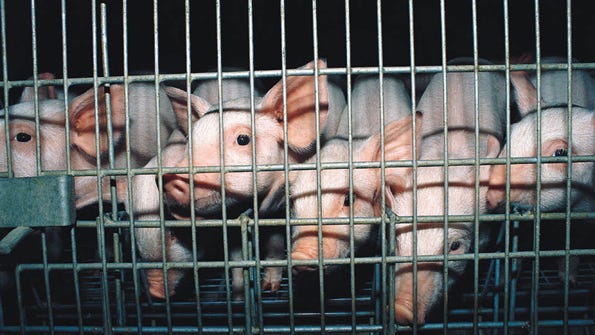Animals raised for meat need a little R.E.S.P.E.C.T
A recent report of animal cruelty in a meat research lab raises questions about future best practices.

 The challenge of feeding a world that's on track to have 9 billion people in it by 2050 is often given as validation for careless food practices, like dousing crops in herbicides, over-fertilizing soil and irresponsibly deregulating certain genetically modified organisms. A recent article in the New York Times illuminates another facet of sketchy science done in the name of a secure food future.
The challenge of feeding a world that's on track to have 9 billion people in it by 2050 is often given as validation for careless food practices, like dousing crops in herbicides, over-fertilizing soil and irresponsibly deregulating certain genetically modified organisms. A recent article in the New York Times illuminates another facet of sketchy science done in the name of a secure food future.
Here are the facts: A government-funded lab called the U.S. Meat Animal Research Center performed experiments that result in animal pain, suffering and premature death. The goal of the center is to improve meat producer profits by making “lamb chops bigger, pork loins less fatty, [and] steaks easier to chew”; this aim is accomplished through selectively breed animals with certain characteristics, the Times reports.
Humans have bred both plants and animals for thousands of years. But the grizzly picture painted in this exposé is hard to swallow, and at times even barbaric. For example, in an odd stab at reverse domestication, researchers aimed to create a sheep that was less of a hassle to care for—one that could give birth and wean its young outside.
“Ranchers commonly shelter ewes giving birth in special barns, which cost money to build, maintain and staff," says the Times. "So the center began sending pregnant sheep out to open pastures in hopes of identifying those that would nurture their babies despite severe weather and predators.” Lambs died from exposure, starvation and coyote raids.
Researchers also bred cattle to give birth to twins and triplets in order to double/triple headcount. But there were frequent complications. “By 2001, the center was reporting that 16.5 percent of twins and triplets were dying, a rate more than four times that of single calves,” the article continues.
Searching for a solution
But here’s the unexpected and downright sad part of the narrative. One reason this disconcerting research exists is because Americans are eating less meat overall. As we continue to fortify our diets with protein from eggs, dairy, nuts, grains and beans, we’re eating less beef, pork and especially lamb. As a result, meat sales are falling. Less meat; less money.
Popular opinion is suspicious of any practice that attempts to alter “natural” processes -- for instance, the concern over GMO crops, and the new movie “Jurassic World,” set to launch this summer, which explores the challenges of biotech when scientists create a new genetically engineered dinosaur (hint: things go awry, to say the least). But the U.S. Meat Animal Research Center hopes to buoy meat producers’ floundering profits by conducting odd experiments that make cows have litters or sheep feral. These initiatives futilely attempt to consolidate centuries-long breeding practices into a few years and place sentient beings at harm. Such experiments do not push science forward.
Indeed, rancher and meat producer operations are at stake—the vast majority of which conduct business in a responsible, law-abiding, humane manner. So I propose an alternate solution to misguided research by presenting the following truisms:
Fact: Americans are eating less red meat.
Fact: Americans increasingly care about eating humanely raised meat.
Fact: Americans are willing to pay more for humanely raised meat.
Animals should be raised (and killed) consciously, which means pain management, better living conditions and ‘enrichments’ such as perches for poultry or wallowing pits for pigs that allow them to express their natural behaviors. Ranchers and meat suppliers could charge a premium for their meat, and consumers wouldn’t mind paying more because it’s eaten sparingly. Profits would level off and even increase.
Preaching that we should all go vegan is fruitless—as my colleague Rick Polito recently wrote, “All-or-nothing attitudes allow little room for progress.”
Shoppers are growing more mindful about what they eat, regardless of whether it's an heirloom tomato or a microwaved hot dog. The animal welfare laws that already apply to ranchers and meat producers must also extend to research labs like the U.S. Meat Animal Research Center to reflect the growing level of consumer respect for a conscious food system.

What does progress in the way of animal welfare look like to you?
About the Author
You May Also Like





